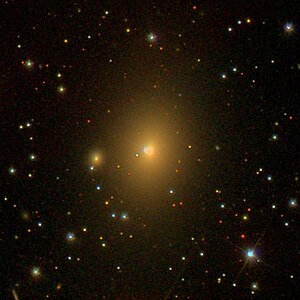NGC 1265
| Galaxy NGC 1265 |
|
|---|---|

|
|
| SDSS | |
| AladinLite | |
| Constellation | Perseus |
|
Position equinox : J2000.0 , epoch : J2000.0 |
|
| Right ascension | 03 h 18 m 15.6 s |
| declination | + 41 ° 51 ′ 28 ″ |
| Appearance | |
| Morphological type | E + / LERG |
| Brightness (visual) | 12.2 mag |
| Brightness (B-band) | 13.2 mag |
| Angular expansion | 1.8 ′ × 1.6 ′ |
| Position angle | 165 ° |
| Surface brightness | 13.4 mag / arcmin² |
| Physical data | |
| Affiliation | Abell 426 |
| Redshift | 0.025137 +/- 0.000237 |
| Radial velocity | 7536 +/- 71 km / s |
|
Stroke distance v rad / H 0 |
(341 ± 24) x 10 6 ly (104.6 ± 7.4) Mpc |
| history | |
| discovery | Guillaume Bigourdan |
| Discovery date | November 14, 1884 |
| Catalog names | |
| NGC 1265 • UGC 02651 • PGC 12287 • CGCG 540-088 • MCG + 07-07-052 • 2MASX i J0318158 + 415127 • LEDA 12287 | |
NGC 1265 is an elliptical galaxy with an active nucleus of the Hubble type E1 in the constellation Perseus in the northern sky . It is an estimated 341 million light years from the Milky Way , has a diameter of about 180,000 ly, and is a member of the Perseus Cluster Abell 426 . In the same area of the sky are u. a. the galaxies NGC 1264 , NGC 1267 , NGC 1268 , IC 312 .
The object was discovered by Guillaume Bigourdan on November 14, 1884 .
Web links
Commons : NGC 1265 - collection of images, videos, and audio files
